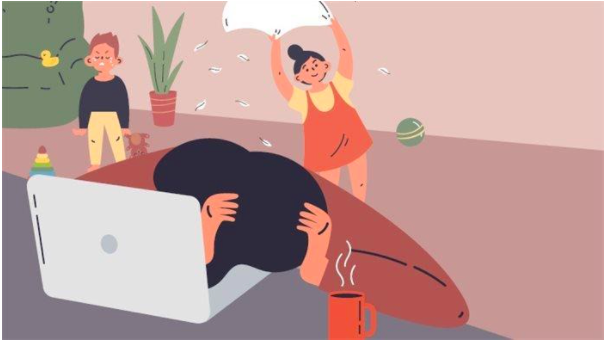COVID-19: Gender Blindness in Media Reporting
Posted on : June 28, 2021Author : Arpita Giri

The world over the onset of the pandemic put a halt to progress towards gender equality and instead exacerbated existing gender inequality. India, which ranks low on various dimensions of the gender inequality index, has witnessed a setback in women’s status across social, economic and political spheres due to challenges arising from COVID-19. However, such concerns and challenges are not adequately represented in Indian media.
Based on the analysis of articles published in twelve mainstream newspapers in seven languages (Assamese, Bengali, English, Hindi, Malayalam, Manipuri and Marathi) between March and September (2020), a recent study reveals the gender biases in reporting in print media. The report not only highlights the gaps in representing the concerns of women but also points towards inefficiency and lack of understanding of caste, class and gender dynamics. There is a continuous acknowledgement of women health care workers and essential workers in reporting, however, it excludes a large number of women from its ambit including women belonging to minority and marginalized groups. There was not a single article on Dalit and Adivasi women. While the media reported on the burden of unpaid work that fell on women during the lockdown period, the articles focused mostly on urban middle-class women and did not include working-class women. The centrality of Gender has not been acknowledged even in the stories that were directly about them. Women were rarely presented as protagonists, sources and experts.
Gender biases in reporting in print media were also visible during the migrant crisis which emerged during the first lockdown (March to June 2020). In May (2020), when millions of migrant workers who were pushed by hunger and unemployment started walking in large caravans, from urban economic centres towards their villages, the media played a crucial role in documenting their sufferings. There was no shortage of reporting on migrant workers during the period. More than 250 pieces were published in May (2020) in The Hindu (Mumbai Edition) highlighting the anxieties faced by migrant workers in the city, their desperation for going home, the apathy of the state towards them along with the coverage of efforts of civil society & voluntary organizations in minimising the sufferings of the workers. However, none of the news pieces explicitly dealt with the voices of women migrant workers. The articles talked about migrants who walked back to villages but were mostly based on responses of male migrants. The experiences of menstruating women or pregnant women during the long, arduous journey rarely surfaced.
The news reports about the loss of livelihood across the informal sector among migrant workers were also about men and the industries in which they were employed. Domestic work in India employs more than fifty million migrant women. But the economic losses, mental trauma faced by them and their healthcare needs have gone unnoticed. The sex work industry relies on migrant women from the poverty-stricken areas of the country. In absence of any work, the majority of them were forced to rely on loans from brothel owners, pimps and others. A study referred to in Indian Express reveals that with the mounting of debts, with no means to repay soon, many may end up trapped in the shackles of debt bondage and sexual slavery.
Women across all categories have been disproportionately affected by the COVID-19 crisis. There has been an alarming rise in Gender-based violence. The National Commission of Women (NCW) pointed out that the cases of domestic violence have almost doubled during lockdown due to the economic insecurity, increased stress level, anxiety, financial worry, and lack of emotional support of family and parents. There is also growing evidence that Child Labour has grown for the first time in nearly two decades. Millions of children were pushed into exploitative work conditions following the closure of the schools. This is further aggravated due to rise in poverty and unemployment among the vulnerable population. Girl child in particular is facing serious discrimination in accessing online education and are pushed for early marriages. In a response to an RTI, it was revealed that between June 2020 to October 2020, there had been an increase in the number of child marriages as compared to the same period in 2019. Childline, a helpline, has reported a 17% increase in distress calls related to the early marriage of girls in June and July of 2020 as compared to 2019. The situation is complex for women in urban areas as well. The responsibilities of women have increased manifold due to the online classes of children along with household responsibilities, which is forcing women to quit the labour market. Between December 2019 and December 2020, women’s labour force participation has decreased by 14 per cent as compared to only 1 per cent for men.
Media plays an important role in society. In times of crisis, its role becomes much more significant in highlighting the concerns of vulnerable, marginalized and oppressed groups.
Media plays an important role in society. In times of crisis, its role becomes much more significant in highlighting the concerns of vulnerable, marginalized and oppressed groups. The current pandemic has exposed the weakness of the state apparatus which has failed to address the concerns of large portions of the population. This exposes vulnerable sections to further marginalization. For example, the absence of migrant women’s concerns and issues in the media will exclude them from the welfare state support system or the formulation of gender-neutral policy which will further disadvantage their position. These issues need to be given adequate space otherwise the media will risk becoming a participant in this deepening of the crisis and reversing the gains made in achieving gender equality.
https://www.unicef.org/press-releases/child-labour-rises-160-million-first-increase-two-decades
https://www.bbc.com/news/world-asia-india-54186709
http://populationfirst.org/wp-content/uploads/2021/03/NWMI-Report_Final_08-03-21.pdf
Arpita Giri
Adjunct Researcher
Asia in Global Affairs





Leave a Reply